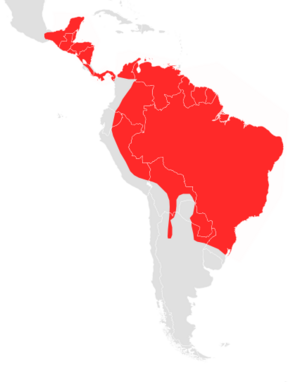Big-eared woolly bat facts for kids
Quick facts for kids Big-eared woolly bat |
|
|---|---|
 |
|
| Conservation status | |
| Scientific classification | |
| Genus: |
Chrotopterus
|
| Species: |
auritus
|
 |
|
| Big-eared woolly bat range | |
The big-eared woolly bat (Chrotopterus auritus) is a fascinating type of bat. It's known for its really big ears and soft, woolly fur! This bat belongs to a family called Phyllostomidae, which includes many different kinds of bats found in the Americas. Its scientific name, Chrotopterus auritus, comes from Greek words meaning "skin/color wing" and Latin for "large-eared," which perfectly describes it.
Contents
About the Big-Eared Woolly Bat
What They Look Like
These bats are quite large, making them the second biggest bat species in places like Central and South America. They usually weigh between 75 to 96 grams, which is about as much as a small apple. Their forearm, which is part of their wing, is about 79 to 83 millimeters long.
Their fur is special because it's very long, around 12 millimeters. This is longer than the fur of most other bats in their family. They also have two small teeth in their lower jaw, which is a feature usually seen in smaller bat species.
Where They Live
Big-eared woolly bats prefer to live in warm, subtropical forests. You can find them in southern parts of Mexico, all the way through Central America, and down into northeastern South America, as far south as Bolivia.
They often make their homes in caves or inside hollow logs. These safe spots are where they bring their food to eat. They usually live in areas where many other bat species also thrive.
What They Eat
These bats have a very interesting diet! They are mostly meat-eaters or insect-eaters. They hunt and eat small bugs like beetles and moths. But they also eat small animals.
Their meals can include tiny opossums, rodents, and even small birds like passerines. Sometimes, they even eat other types of bats! A unique food item for them is geckos, which is rare for New World bats.
They can catch prey that weighs up to 70 grams, but they usually go for smaller animals, weighing between 10 and 35 grams. They don't eat their prey right away. Instead, they fly back to their roost and hang upside down before enjoying their meal.
While they mostly eat meat and insects, they have been known to eat fruit sometimes. However, when kept in captivity, they often refuse fruit, showing they really prefer meat or insects.
How They Behave
Big-eared woolly bats are not very fast flyers. Because of their large size, they tend to fly slowly, usually just 1 or 2 meters above the ground. They often fly through thick bushes and dense parts of the forest.
These bats are usually quite private. They are either found living alone or in very small groups. A colony might have between one and seven bats. These small groups often consist of a male and female adult pair, along with their baby bats, called pups.
How They Reproduce
Big-eared woolly bats usually have only one baby, or pup, at a time. The mother carries the baby for a long time, more than 100 days, before it is born. This is a very long pregnancy for a bat in their family.
When a pup is born, it's quite large compared to its mother. A newborn pup is about 32.5% of the mother's size. For most other bats in the Phyllostomid family, newborns are much smaller, usually between 18.6% and 29.4% of the mother's size. This shows that big-eared woolly bat mothers put a lot of care and energy into raising their single young.
See also
 In Spanish: Falso vampiro orejón para niños
In Spanish: Falso vampiro orejón para niños


